
Recurring Martian Streaks: Flowing Sand, Not Water?
Jet PropulsionRecurring Martian Streaks: Flowing Sand, Not Water?
×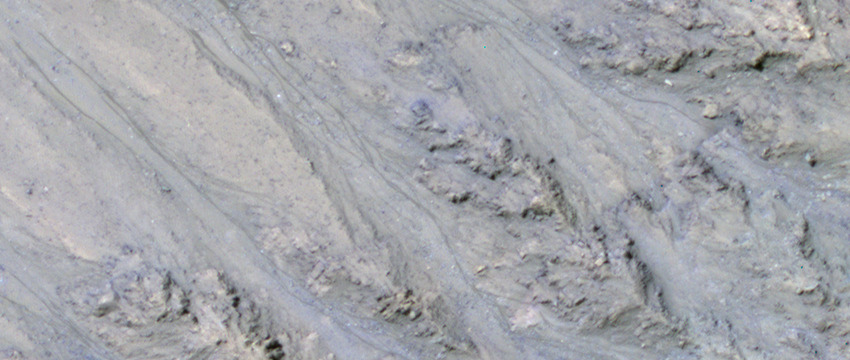
Jet Propulsion Laboratory/Caltech and University Communications - Nov. 21, 2017
Dark features on Mars previously considered evidence for subsurface flowing of water are interpreted by new research as granular flows, where grains of sand and dust slip downhill to make dark streaks, rather than the ground being darkened by seeping water.
Continuing examination of these still-perplexing seasonal dark streaks with the UA-led High Resolution Imaging Science Experiment, or HiRISE, camera on NASA's Mars Reconnaissance Orbiter, or MRO, shows they exist only on slopes steep enough for dry grains to descend the way they do on faces of active dunes.
The findings published in Nature Geoscience argue against the presence of enough liquid water for microbial life to thrive at these sites. However, exactly how these numerous flows begin and gradually grow has not yet been explained. Authors of the report propose possibilities that include the involvement of small amounts of water, indicated by detection of hydrated salts observed at some of the flow sites.
These features have evoked fascination and controversy since their 2011 discovery, as possible markers for unexpected liquid water or brine on an otherwise dry planet. They are dark streaks that extend gradually downhill in warm seasons, then fade away in winter and reappear the next year. On Earth, only seeping water is known to have these behaviors, but how they form in the dry Martian environment remains unclear.
Many thousands of these Martian features, collectively called "recurring slope lineae," or RSL, have been identified in more than 50 rocky-slope areas, from the equator to about halfway to the poles.
'Mars Today Is Very Dry'
"We've thought of RSL as possible liquid water flows, but the slopes are more like what we expect for dry sand," said Colin Dundas of the U.S. Geological Survey's Astrogeology Science Center in Flagstaff, Arizona. "This new understanding of RSL supports other evidence that shows that Mars today is very dry."
Dundas is lead author of the report, which is based on observations with the HiRISE camera on MRO. The data include 3-D models of slope steepness using pairs of images for stereo information. Dundas and co-authors examined 151 RSL features at 10 sites.
The RSL are almost all restricted to slopes steeper than 27 degrees. Each flow ends on a slope that matches the dynamic "angle of repose" seen in the slumping dry sand of dunes on Mars and Earth. A flow due to liquid water should readily extend to less steep slopes.
"The RSL don't flow onto shallower slopes, and the lengths of these are so closely correlated with the dynamic angle of repose, it can't be a coincidence," said HiRISE principal investigator Alfred McEwen at the UA's Lunar and Planetary Laboratory, a co-author of the new report.
The seasonal dark streaks have been thought of as possible evidence for biologically significant liquid water — sufficient water for microbial life — although explaining how so much liquid water could exist on the surface in Mars' modern environment would be challenging. A granular-flow explanation for RSL fits with the earlier understanding that the surface of modern Mars, exposed to a cold, thin atmosphere, lacks flowing water. A 2016 report also cast doubt on possible sources of underground water at RSL sites. Liquid water on today's Mars may be limited to traces of dissolved moisture from the atmosphere and thin films, which are challenging environments for life as we know it.
However, RSL remain puzzling. Traits with uncertain explanations include their gradual growth, their seasonal reappearance, their rapid fading when inactive, and the presence of hydrated salts, which have water molecules bound into their crystal stucture.
RSL Formation a Mystery
The new report describes possible connections between these traits and how RSL form. For example, salts can become hydrated by pulling water vapor from the atmosphere, and this process can form drops of salty water. Seasonal changes in hydration of salt-containing grains might result in some trigger mechanism for RSL grainflows, such as expansion, contraction or release of some water. Darkening and fading might result from changes in hydration. If atmospheric water vapor is a trigger, then a question is why the RSL appear on some slopes but not others.
"RSL probably form by some mechanism that is unique to the environment of Mars," McEwen said, "so they represent an opportunity to learn about how Mars behaves, which is important for future surface exploration."
"Full understanding of RSL is likely to depend upon on-site investigation of these features," said MRO project scientist Rich Zurek of NASA's Jet Propulsion Laboratory in Pasadena, California. "While the new report suggests that RSL are not wet enough to favor microbial life, it is likely that on-site investigation of these sites will still require special procedures to guard against introducing microbes from Earth, at least until they are definitively characterized. In particular, a full explanation of how these enigmatic features darken and fade still eludes us. Remote sensing at different times of day could provide important clues."
Operated by the UA, HiRISE was built by Ball Aerospace & Technologies Corp. of Boulder, Colorado. JPL, a division of Caltech in Pasadena, California, manages the MRO project for the NASA Science Mission Directorate in Washington. Lockheed Martin Space Systems of Denver built the orbiter and supports its operations.
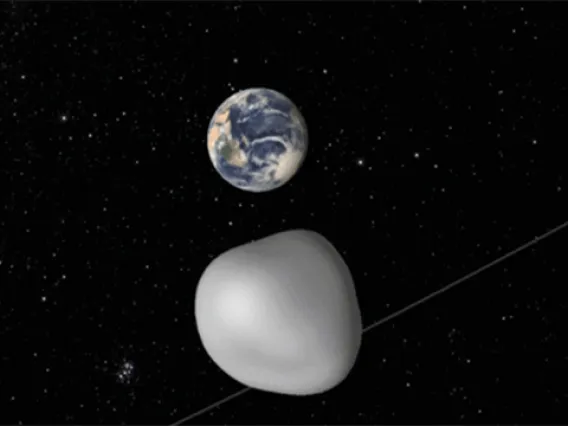
Earth's New Buddy Is Asteroid, Not Space Junk
By Daniel StolteEarth's New Buddy Is Asteroid, Not Space Junk
×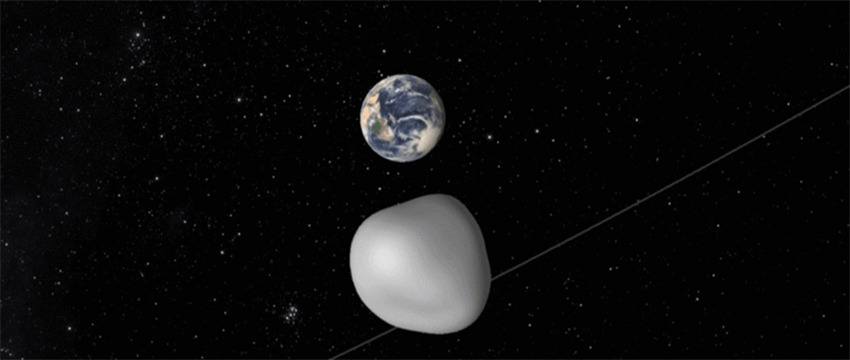
By Daniel Stolte, University Communications and Vishnu Reddy,LPL - Oct. 17, 2017
Is it a bird? Is it a plane? Or maybe, as some have speculated, a burned-out rocket booster, trapped in a near-Earth orbit around the sun and only occasionally getting close enough to be studied with even the largest telescopes?
Not at all, as it turns out. Based on previous observations, most astronomers had strongly suspected that object (469219) 2016 HO3 was an ordinary asteroid and not space junk. But it took a team of astronomers led by Vishnu Reddy, assistant professor at the University of Arizona's Lunar and Planetary Laboratory, working with one of the world's largest telescopes, the Large Binocular Telescope, or LBT, on Mount Graham in southeastern Arizona, to learn the true nature of this near-Earth object.
2016 HO3 is a small near-Earth object, or NEO, measuring no more than 100 meters (330 feet) across that, while orbiting the sun, also appears to circle around the Earth as a "quasi-satellite." Only five quasi-satellites have been discovered so far, but 2016 HO3 is the most stable of them. The provenance of this object is unknown. On timescales of a few centuries, 2016 HO3 remains within 38-100 lunar distances from us.
"While HO3 is close to the Earth, its small size — possibly not larger than 100 feet — makes it challenging target to study," Reddy said. "Our observations show that HO3 rotates once every 28 minutes and is made of materials similar to asteroids."
Soon after its discovery in 2016, astronomers were not sure where this object came from, but in a recent presentation at the annual Division for Planetary Sciences Conference of the American Astronomical Society in Provo, Utah, Reddy and his colleagues showed that Earth's new traveling buddy is an asteroid and not space junk. The new observations confirm that 2016 HO3 is a natural object of similar provenance to other small NEOs that zip by the Earth each month.
"In an effort to constrain its rotation period and surface composition, we observed 2016 HO3 on April 14 and 18 with the Large Binocular Telescope and the Discovery Channel Telescope," Reddy said. "The derived rotation period and the spectrum of emitted light are not uncommon among small NEOs, suggesting that 2016 HO3 is a natural object of similar provenance to other small NEOs."
In their presentation "Ground-based Characterization of Earth Quasi Satellite (469219) 2016 HO3" at the 49th annual Division for Planetary Sciences meeting in Utah, Reddy and his co-authors, Olga Kuhn, Audrey Thirouin, Al Conrad, Renu Malhotra, Juan Sanchez and Christian Veillet, point out that the light reflected off the surface of 2016 HO3 is similar to meteorites we have on Earth.
One way to visualize HO3's orbit is by picturing a hula hoop dancer — the sun in this analogy — twirling two hoops around the hips at the same time, ever so slightly out of sync. While it orbits the sun, the object makes yearly loops around the Earth. As a result, the object appears to orbit the Earth, but it is not gravitationally bound to our planet.
"Of the near-Earth objects we know of, these types of objects would be the easiest to reach, so they could potentially make suitable targets for exploration," said Veillet, director of the LBT Observatory. "With its binocular arrangement of two 8.4-meter mirrors, coupled with a very efficient pair of imagers and spectrographs like MODS, LBT is ideally suited to the characterization of these Earth's companions."
NASA Near-Earth Object Observations Program Grant NNX17AJ19G (PI: Reddy) funded parts of this work.

Earth to OSIRIS-REx Cameras: I'm Ready for My Close-Up
UniversityEarth to OSIRIS-REx Cameras: I'm Ready for My Close-Up
×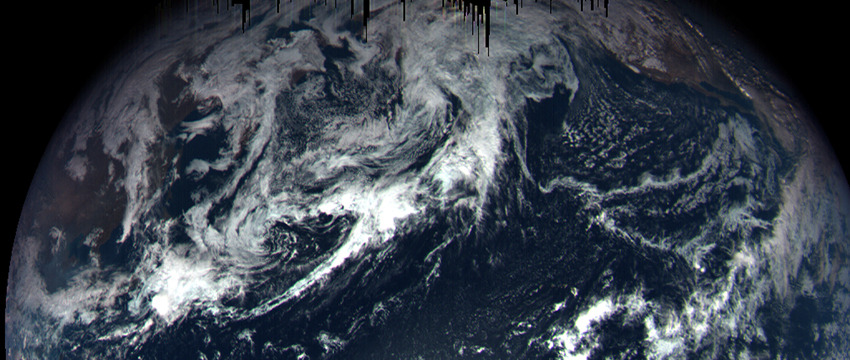
University Communications - October 4, 2017
On Sept. 22, OSIRIS-REx soared under the South Pole, coming within 10,600 miles of Earth before using the planet's gravity to slingshot itself onto the path to the asteroid Bennu.
The flyby was the perfect opportunity for the OSIRIS-REx team to calibrate and test the science instruments on the craft — and exercise the team.
"It’s really important that all of the team members know where they fit in the processes and that the lines of communication are well understood," said Heather Enos, deputy principal investigator of the mission led by the University of Arizona.
NavCam 1 — a navigational camera operated by Lockheed Martin — captured OSIRIS-REx's first black-and-white image of Earth, taken at a distance of 69,000 miles. Hurricane Maria and the remnants of Hurricane Jose can be seen in the upper right of the image.
About 37,000 miles farther away, MapCam snapped a series of images of Earth, using five different filters. The mission's image processing team at the UA combined the images to create the color composite of Earth.
MapCam is designed to photograph Bennu, a body that reflects only 4 percent of the sunlight that hits it; it is darker than coal. Earth is much, much brighter than that, so the image had to be taken using extremely short exposure times, causing the appearance of dark "icicles" at the top of the color portrait of Earth.
"MapCam was taking the data as quickly as it can," principal investigator Dante Lauretta said. "There was just some noise left on the detector. We won't have any of those features when we're at Bennu."
As it flew away from Earth, OSIRIS-REx aimed its spectrometers at our home planet. Those instruments performed a unique observation: collecting spectral data over Earth's entire visible surface.
"We’ll be doing some interesting science with it, so stay tuned," Lauretta said.
OSIRIS-REx is scheduled to get up close and personal with the 4.5 billion-year-old asteroid in November 2018. After searching the sky around Bennu for other bodies, assessing the asteroid's risk of impact with Earth, using the spectrometers to analyze its chemistry and collecting a sample from its surface, OSIRIS-REx will return to Earth in 2023.
From the mission, researchers hope to learn more about the origins of life and the solar system.
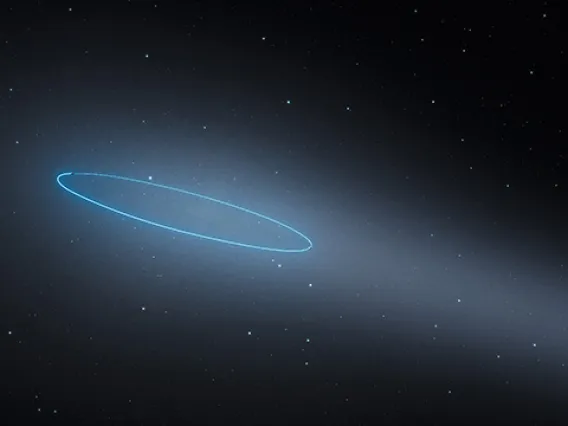
Asteroid-Comet Is New Type of Object
By ESA/Hubble SpaceAsteroid-Comet Is New Type of Object
×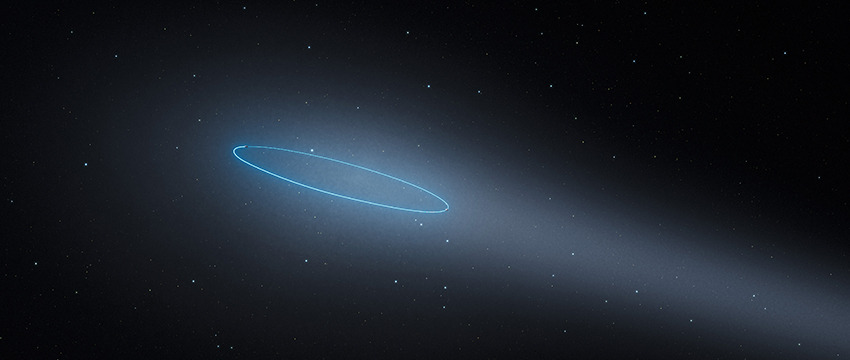
By ESA/Hubble Space Telescope and Daniel Stolte, University Communications - Sept. 25, 2017
With the help of the NASA/ESA Hubble Space Telescope, astronomers have observed the intriguing characteristics of an unusual type of object in the asteroid belt between Mars and Jupiter: two asteroids orbiting each other and exhibiting cometlike features, including a bright coma and a long tail. This is the first known binary asteroid also classified as a comet. The research is published in the journal Nature.
Asteroid 288P was discovered by the University of Arizona's SPACEWATCH® program in 2006, according to Stephen Larson, a senior staff scientist at the UA's Lunar and Planetary Laboratory and a co-author on the paper. Cometary activity was noticed in Hawaii Pan-Starrs data in 2011 as it approached perihelion — close approach to the sun — and is the first known "main belt comet" as it orbits in the main asteroid belt between Mars and Jupiter.
In September 2016, just before the asteroid 288P made its closest approach to the sun, it was close enough to Earth to allow astronomers a detailed look at it using the NASA/ESA Hubble Space Telescope. Like any object orbiting the sun, 288P travels along an elliptical path, bringing it closer to and farther away from the sun during the course of one orbit.
The images of 288P revealed that it actually was not a single object but two asteroids of almost the same mass and size, orbiting each other at a distance of about 100 kilometers (62 miles). That discovery was in itself an important find; because they orbit each other, the masses of the objects in such systems can be measured.
But the observations also revealed ongoing activity in the binary system. The team of authors of this paper has been working for several years trying to identify the mechanism for the observed activity using the Hubble Space Telescope, Larson said.
"These so-called active asteroids are likely comets that have lost most of their volatile ices and may provide the link between comets and some asteroids," he said. "There are about 20 known active asteroids that result from collisions, volatile gas outgassing and splitting due to rotational spin-up."
"We detected strong indications of the sublimation of water ice due to the increased solar heating — similar to how the tail of a comet is created," explained Jessica Agarwal of the Max Planck Institute for Solar System Research in Germany, the team leader and main author of the research paper. This makes 288P the first known binary asteroid that also is classified as a main-belt comet.
Understanding the origin and evolution of main-belt comets — asteroids orbiting between Mars and Jupiter that show comet-like activity — is a crucial element in our understanding of the formation and evolution of the whole solar system. Among the questions main-belt comets can help to answer is how water came to Earth. Current research indicates that water came to Earth not via comets, as long thought, but via icy asteroids. Since only a few objects of this type are known, 288P presents itself as an extremely important system for future studies.
"The high resolution of the Hubble Space Telescope provides unique data constraining the various processes at work in active asteroids," Larson said. "A few of these have been discovered by the UA Catalina Sky Survey, which also provides 14 years of data on historical activity of these active asteroids."
The various features of 288P — wide separation of the two components, near-equal component size, high eccentricity and cometlike activity — also make it unique among the few known wide asteroid binaries in the solar system. The observed activity of 288P also reveals information about its past, Agarwal noted: "Surface ice cannot survive in the asteroid belt for the age of the solar system but can be protected for billions of years by a refractory dust mantle, only a few meters thick."
From this, the team concluded that 288P has existed as a binary system for only about 5,000 years. Agarwal elaborated on the formation scenario: "The most probable formation scenario of 288P is a breakup due to fast rotation. After that, the two fragments may have been moved further apart by sublimation torques."
The fact that 288P is so different from all other known binary asteroids raises some questions about whether it is not just a coincidence that it presents such unique properties. As finding 288P included a lot of luck, it is likely to remain the only example of its kind for a long time. "We need more theoretical and observational work, as well as more objects similar to 288P, to find an answer to this question," Agarwal concludes.
The Hubble Space Telescope is a project of international cooperation between ESA and NASA.
The international team of astronomers in this study consists of Jessica Agarwal (Max Planck Institute for Solar System Research, Göttingen, Germany), David Jewitt (Department of Earth, Planetary and Space Sciences and Department of Physics and Astronomy, University of California, Los Angeles), Max Mutchler (Space Telescope Science Institute, Baltimore), Harold Weaver (Johns Hopkins University Applied Physics Laboratory, Maryland) and Stephen Larson (Lunar and Planetary Laboratory, UA).
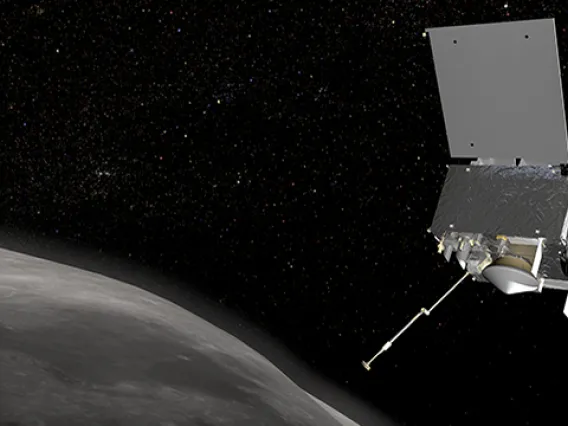
OSIRIS-REx Swings by Earth
By Daniel StolteOSIRIS-REx Swings by Earth
×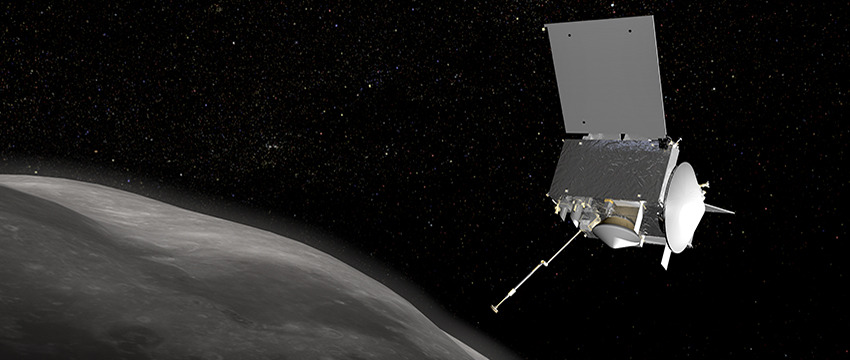
By Daniel Stolte, University Communications - September 20, 2017
As you are reading this, a spacecraft is coming right at you.
Hurtling toward Earth at 19,058 mph, the OSIRIS-REx spacecraft has completed one orbit around the sun since its launch on Sept. 8, 2016. The robotic explorer of the University of Arizona-led asteroid sample return mission is now readying itself for a maneuver that will place it on a trajectory to catch up with Bennu, its target asteroid, a year from now.
In preparation for the Earth gravity assist maneuver, members of all teams involved in the mission are flocking to the UA's Michael J. Drake Building to rehearse operations that the spacecraft will have to perform once it reaches Bennu and begins its surveying campaign to get ready to grab a sample of asteroid material and bring that back to Earth.
"This is the first time for members of all teams to be located here at the Drake Building and lace together as one team," says deputy principal investigator Heather Enos, who has been involved in several NASA missions in which the UA participated. "Our biggest challenge is coordinating all the moving parts. Staying organized requires knowing each other very well and, most of all, trust. Whoever you delegate to can open your door at any time and say, 'We need to talk.'"
During the weeklong, carefully orchestrated move, the probe will approach Earth to within 10,700 miles, well below the orbit of geostationary satellites. It will then dive south under Antarctica, and up over the Pacific Ocean, before setting sail for its journey through outer space to rendezvous with Bennu. As it speeds away from Earth, it will look back and take pictures of the Earth and moon.
Unlike most such maneuvers, which are designed to accelerate a spacecraft by "stealing" momentum from a planetary body's orbit around the sun, OSIRIS-REx will use Earth to change its orbital plane, in a similar way that a skillful throw of a line onto a mooring pole can help a skipper maneuver a boat around a dock.
According to Erin Morton, communications lead for the OSIRIS-REx mission, OSIRIS-REx is one of only a few NASA spacecraft that have performed an Earth gravity assist maneuver, or EGA.
A Need for Speed? Not Really
"This is not about gaining speed," Morton says. "We have all the speed we need to catch up with Bennu. But to get onto the asteroid's orbit, OSIRIS-REx has to boost itself slightly above the plane on which Earth travels around the solar system. Placing it onto that trajectory at launch would have required excessive amounts of rocket fuel, so we're using Earth's gravity instead."
The close encounter provides mission scientists and engineers with the first opportunity since the spacecraft's launch to gather at the OSIRIS-REx Science Processing Operations Center, or SPOC, in the Drake Building, which is a short distance northwest of the UA main campus. Referred to as a co-location by mission managers, the weeklong activities provide a valuable opportunity to rehearse procedures and test and calibrate scientific instruments. As many as 30 scientists, technicians, engineers and other mission members — including several representatives from out of state — are expected to work together during the flyby. Once OSIRIS-REx gets to asteroid Bennu, SPOC will bustle with about 120 people at any given time.
Unlike most space missions, in which the science team members leave most of the spacecraft's day-to-day operations to the flight and system engineers and only spring into action once the craft begins to send science data back to Earth, OSIRIS-REx is more similar to a 17th-century expedition aboard a sailing ship. Just as the naturalists were part of the trip, studying foreign waters and lands as they encountered them, discoveries made by the OSIRIS-REx scientists will be used to inform the spacecraft's operations. Such a high level of intertwined overlap among teams is unusual, according to Morton.
"Much of this mission is about reconnaissance," she explains. "Until we actually get to the asteroid, we won't know what to expect, and what potential hazards might be awaiting the spacecraft."
Lead science operations engineer Sara Knutson, who graduated from the UA with a master's degree in engineering management, has spent the year since launch with her team mapping out what actions the science payload instruments aboard the spacecraft will be performing once at the asteroid — down to the hour. This includes planning all the observations the science instruments will be performing while it orbits Bennu to survey the asteroid in preparation for selecting a sample site.
"Let's say one of the mission scientists wanted to look at a particular swath of material on the asteroid surface," Knutson says. "My team members would then determine where we have to point the spacecraft, and what we have to do once we are in that position — for example, which cameras or spectrometers have to be turned on at what times."
Precision for the Payload
Knutson's team writes commanding sequence products that lay out the exact steps for any given operation of the spacecraft's science payload — in a sense, they allow the ground crew to talk to the spacecraft and control every one of its activities.
"For example, how do we need to orient the spacecraft if we want to point a camera at a science target?" Knutson says. "How do we need to orient the solar panels to ensure we have enough power to acquire the science objective we are looking for, and how long can we remain in that position before we run out of power? Those are the kinds of questions that we ask and develop protocols for."
Before any commands are sent, her team thoroughly tests each data product and works with the spacecraft team to make sure everything is within specs. Once a science operation has been performed, Knutson's team verifies that every task was completed as planned.
"Let's say a scientist asked for pictures or spectrometric data of a site on the asteroid," Knutson says. "Our job is then to check: Did we get all 250 images from the spacecraft, or are we missing an hour's worth of spectrometer data? Our team monitors all that. There is a constant cycle of reviewing an action and feeding the results back into future plans. We want to make sure we keep track of what we have learned to adjust our procedures for future operations."
Taking pictures of the Earth and moon provides a critical opportunity to calibrate the spacecraft's instruments, according to Knutson, as it ensures that the instruments work as intended once they are at the asteroid.
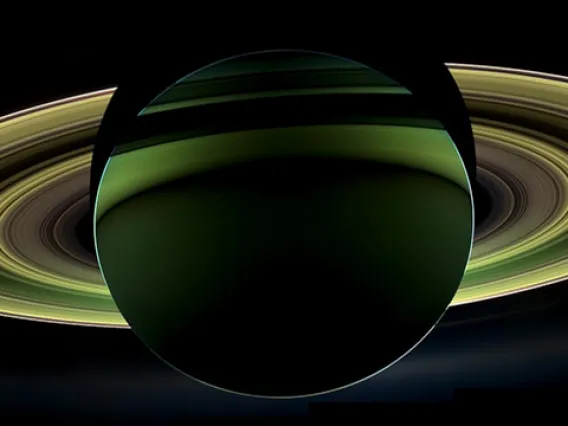
After Farewell Kiss, Cassini Takes the Plunge
By Daniel StolteAfter Farewell Kiss, Cassini Takes the Plunge
×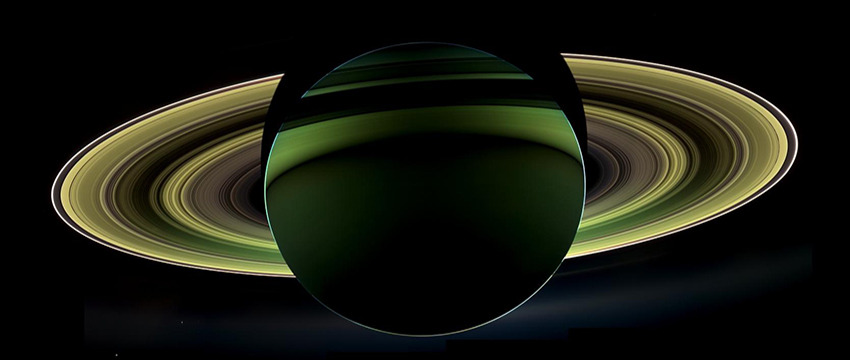
By Daniel Stolte, University Communications - September 13, 2017
When NASA's Cassini spacecraft careens to its final destination, the upper atmosphere of Saturn, it will take with it a sizable chunk of University of Arizona space research history. After a journey of 4.9 billion miles, and one month shy of 20 years in space, the probe is programmed to end its voyage exploring the Saturnian system through a deliberate plunge into the second-largest planet of the solar system.
The spacecraft's fateful dive on Friday will be the final beat in the mission's Grand Finale — 22 weekly dives, begun in late April, through the gap between Saturn and its rings. According to NASA, no spacecraft has ever ventured so close to the planet before.
"Cassini-Huygens is a classic example of a 'flagship' mission, accomplishing tremendous science in many disciplines over many years," said Alfred McEwen, a UA professor of planetary sciences, on Monday as he prepared to leave for Pasadena, California. There, at NASA's Jet Propulsion Laboratory, he would attend the final moments of the mission, along with other UA planetary scientists who have participated in the project.
NASA chose to end the mission by safely disposing of the spacecraft, burning it up in Saturn's atmosphere rather than allowing it to run out of fuel and committing its fate to an aimless tumble and potential crash onto one of Saturn's moons. Mission scientists were especially concerned about contaminating Titan or Enceladus, the two Saturnian moons where life as we know it might be possible — a possibility discovered by Cassini's multiple flybys.
When it launched, Cassini-Huygens was the biggest, most complex interplanetary spacecraft ever flown. In 2004, it arrived in the Saturn system, carrying with it a robotic passenger in form of the Huygens probe, contributed to the mission by the European Space Agency, or ESA. On Jan. 14, 2005, Huygens would make history as the first — and, so far, only — humanmade object to touch down on a world in the outer solar system. Through the eyes of Huygens, an instrument built by UA scientists and engineers, people on Earth could watch as the probe hurtled through the opaque and hazy atmosphere enshrouding Titan.
The probe was equipped with an instrument called DISR, short for Descent Imager/Spectral Radiometer. Led by Martin Tomasko, a now-retired research professor at the Lunar and Planetary Laboratory, UA scientists joined their ESA colleagues in Germany to follow Huygens with six science experiments as it descended through Titan's thick atmosphere until it touched down on a virtually unseen surface. In addition to images taken with DISR, the lander recorded data that enabled LPL staff scientist Erich Karkoschka to gather surprising clues about Titan's surface many years after the event.
Monitoring the Moon Titan
During many flybys, Cassini monitored the dynamic Titan using its camera suite and an instrument called VIMS, a Visual and Infrared Mapping Spectrometer. Built at Jet Propulsion Laboratory under the leadership of Robert Brown, operations for VIMS moved to the UA when Brown assumed a position as professor at LPL. According to Brown, VIMS has been taking spectra over areas of Saturn, its rings and moons so scientists can discover what these objects are made of.
Those observations revealed details about the cycle of methane, which on Titan takes the role of water on Earth — forming clouds, raining down and forming lakes, as well as freezing into ice. In all those observations, Cassini's cameras played an important role, said McEwen, who is a team member of the craft's imaging science subsystem. Those cameras, over the years of photographing Saturn, its rings and moons, created some of the most visually beautiful images of the solar system.
Cassini's imaging team leader Carolyn Porco was appointed to the mission while on the faculty at LPL, where she had been working on NASA's Voyager mission, and was a co-originator of the idea to use Voyager-1 to take portraits of the planets, including the famous Pale Blue Dot image of Earth.
Surface observations on Titan are planned at LPL, and then sent to the Cassini Imaging Central Laboratory for Operations, or CICLOPS, at the University of Colorado, Boulder, which Porco heads as director.
"From there, the necessary commands are sent to JPL and then to the spacecraft," McEwen explains.
Another one of Saturn's moons, ice-clad Enceladus, rose to stardom during several flybys over the course of the mission. Enceladus plows along the orbit of the E Ring, Saturn's second-from-outermost ring, which reaches extremely far out into space, brushing up against the orbit of Titan.
"There was speculation that the moon had something to do with the E Ring," McEwen says.
During multiple close flybys, Cassini used its full science payload to detect and analyze water-rich plumes erupting from the moon's south pole far into space, a spectacular discovery that McEwen considers one of the highlights of the entire mission.
"We saw that these plumes are quite large and extensive," he recalls. "Because we were able to measure their composition with Cassini's instruments, we could show that (tiny particles from those eruptions) are the source of the E Ring."
The Last Closest Approach
Evidence for subsurface oceans of water were discovered by Cassini inside both Enceladus and Titan, making them prime targets for future NASA missions.
Cassini made its last closest approach to Titan on Sept. 11 at 12:04 p.m. PDT, at an altitude of 73,974 miles (119,049 kilometers) above the moon's surface, causing the spacecraft to slingshot into its final approach to Saturn — but not before it would send final images from Titan to Earth, eagerly awaited by scientists, including McEwen.
"Previously, we saw thunderstorms in Titan's southern hemisphere when it was summer there," he says, "and because it's now the northern summer solstice, we are hoping to see cloud activity and perhaps thunderstorms in the northern hemisphere."
Cassini will be doing science even after being gripped by Saturn's gravity, pulling it into destruction, by measuring the composition, temperature and other properties of Saturn's atmosphere.
"The spacecraft will be transmitting data until the very end, and we'll be there when it stops," McEwen says. "It won't go very deep, because it is not a probe designed to go deep, but still deeper than anything else."
When Cassini arrived at Saturn, where one "year" lasts 29.5 Earth years, the gas giant went through northern winter, and Cassini was there to witness the planet's change of seasons.
The end of the mission, McEwen says, is "not unexpected," adding that the plan to end with a solstice mission, followed by a plunge into Saturn, was put in place about seven years ago.
Still, "this mission has been going for so long, it's a little hard to believe that it's over," he says.

Stellar Corpse Sheds Light on Cosmic Rays
By Daniel StolteStellar Corpse Sheds Light on Cosmic Rays
×
By Daniel Stolte, University Communications - September 4, 2017
The origin of cosmic rays, high-energy particles from outer space unceasingly impinging on Earth, is among the most challenging open questions in astrophysics.
Discovered more than 100 years ago and considered a potential health risk to airplane crews and astronauts, cosmic rays are believed to be produced by shock waves — for example, those resulting from supernovae explosions. The most energetic cosmic rays streaking across the universe carry 10 to 100 million times the energy generated by particle colliders such as the Large Hadron Collider at CERN. New research published in the Monthly Notices of the Royal Astronomical Society sheds new light on the origin of those energetic particles.
"The new result represents a significant advance in our understanding of particle acceleration at shock waves, traditionally regarded as the main sources of energetic particles in the universe," said the study's lead author, Federico Fraschetti, a staff scientist at the University of Arizona's Departments of Planetary Sciences and Astronomy.
The Crab Nebula, remnant of a supernova explosion that was observed almost 1,000 years ago, is one of the best studied objects in the history of astronomy and a known source of cosmic rays. It emits radiation across the entire electromagnetic spectrum, from gamma rays, ultraviolet and visible light, to infrared and radio waves.
"Most of what we observe comes from very energetic particles such as electrons that did not yet leave the source," said Fraschetti. "Since we can only observe the electromagnetic radiation that they emit from the source itself, we rely on models to reproduce the radiation spectrum we see from the nebula."
The new study, co-authored by Martin Pohl at the University of Potsdam, Germany, revealed that the entire zoo of electromagnetic radiation streaming from the Crab Nebula can arise from a single population of electrons, previously deemed impossible, and that they originate in a different way than scientists have traditionally thought.
According to the generally accepted model, once the particles reach the shock, they bounce back and forth many times due to the magnetic turbulence. During this process they gain energy — in a similar way to a tennis ball being bounced between two rackets that are steadily moving nearer to each other — and are pushed closer and closer to the speed of light. Such a model follows an idea introduced by Italian physicist Enrico Fermi in 1949.
"The current models do not include what happens when the particles reach their highest energy," said Federico Fraschetti. "Only if we include a different process of acceleration can we explain the entire electromagnetic spectrum we see, and that tells us that while the shock wave still is the source of the acceleration of the particles, the mechanisms must be different."
At the heart of the Crab Nebula lies a pulsar, a rapidly rotating neutron star originating from the explosion of a star a few times more massive than the sun. When it exploded, the star shredded its outer layers, creating the stunning colorscape that makes the Crab Nebula so popular with professional and amateur astronomers. The pulsar emits a wind of electrons and positrons traveling at what astrophysicists call relativistic speed — close to the speed of light.
"Those particles are the fastest things in the universe," Fraschetti said. "Anything we experience in our everyday lives is very far from relativistic effects. But these highly energetic particles still need to be accelerated even more to produce the electromagnetic radiation that we see coming from the Crab Nebula."
That acceleration, scientists believe, happens at a boundary called the termination shock, where the particle wind slams into the cloud of gas and dust that the star blew off into space when it went supernova.
Except that just when the particles become energetic enough to leave the system and become cosmic radiation, they go beyond the limits of the models traditionally used to account for the origin of cosmic radiation, Fraschetti and Pohl found. The authors conclude that a better understanding is needed of how particles are accelerated in cosmic sources, and how the acceleration works when the energy of the particles become very large.
Several NASA missions, including ACE, STEREO and WIND, are dedicated to studying the effects of shocks caused by plasma explosions on the surface of the sun as they travel to Earth. Scientists hope that results from those experiments may shed light on the mechanisms of acceleration in objects such as the Crab Nebula.
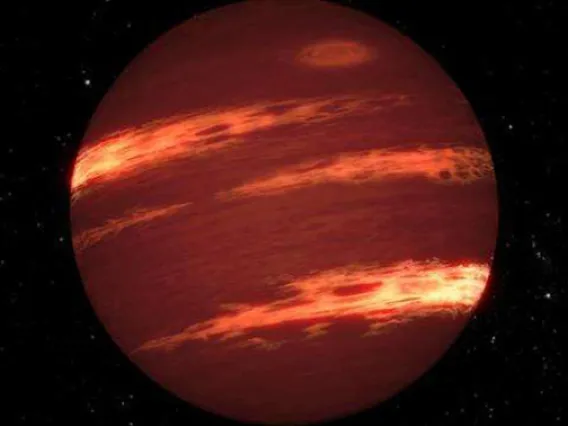
Scientists Solve Mystery of Blinking Brown Dwarfs
By UniversityScientists Solve Mystery of Blinking Brown Dwarfs
×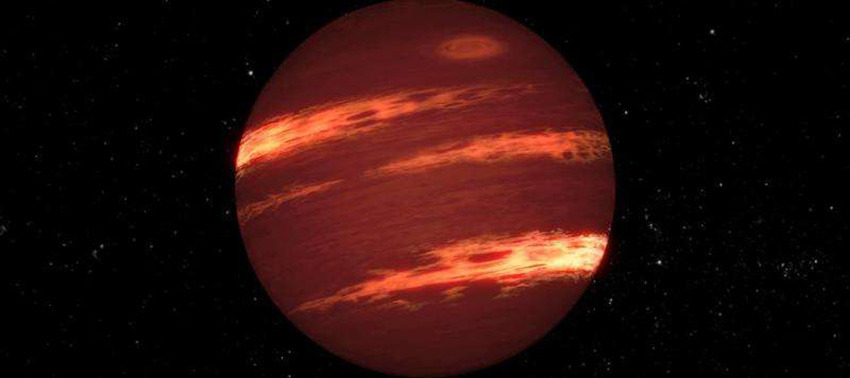
By University Communications - August 17, 2017
Dim objects called brown dwarfs, less massive than the sun but more massive than Jupiter, have powerful winds and clouds -- specifically, hot patchy clouds made of iron droplets and silicate dust. Scientists recently realized these giant clouds can move and thicken or thin surprisingly rapidly, in less than an Earth day, but did not understand why.
Now, researchers have a new model for explaining how clouds move and change shape in brown dwarfs, using insights from NASA's Spitzer Space Telescope. Giant waves cause large-scale movement of particles in brown dwarfs' atmospheres, changing the thickness of the silicate clouds, researchers report in the journal Science. The study also suggests these clouds are organized in bands confined to different latitudes, traveling with different speeds in different bands.
"This is the first time we have seen atmospheric bands and waves in brown dwarfs," said lead author Daniel Apai, associate professor of astronomy and planetary sciences at the University of Arizona's Steward Observatory.
Just as in Earth's ocean, different types of waves can form in planetary atmospheres. For example, in Earth's atmosphere, very long waves mix cold air from the polar regions to mid-latitudes, which often lead clouds to form or dissipate.
The distribution and motions of the clouds on brown dwarfs in this study are more similar to those seen on Jupiter, Saturn, Uranus and Neptune. Neptune has cloud structures that follow banded paths too, but its clouds are made of ice. Observations of Neptune from NASA's Kepler spacecraft, operating in its K2 mission, were important in this comparison between the planet and brown dwarfs.
"The atmospheric winds of brown dwarfs seem to be more like Jupiter's familiar regular pattern of belts and zones than the chaotic atmospheric boiling seen on the Sun and many other stars," said study co-author Mark Marley at NASA's Ames Research Center in California's Silicon Valley.
Brown dwarfs can be thought of as failed stars because they are too small to fuse chemical elements in their cores. They can also be thought of as "super planets" because they are more massive than Jupiter, yet have roughly the same diameter. Like gas giant planets, brown dwarfs are mostly made of hydrogen and helium, but they are often found apart from any planetary systems. In a 2014 study using Spitzer, scientists found that brown dwarfs commonly have atmospheric storms.
Due to their similarity to giant exoplanets, brown dwarfs are windows into planetary systems beyond our own. It is easier to study brown dwarfs than planets because they often do not have a bright host star that obscures them.
"It is likely the banded structure and large atmospheric waves we found in brown dwarfs will also be common in giant exoplanets," Apai said.
Using Spitzer, scientists monitored brightness changes in six brown dwarfs over more than a year, observing each of them rotate 32 times. As a brown dwarf rotates, its clouds move in and out of the hemisphere seen by the telescope, causing changes in the brightness of the brown dwarf. Scientists then analyzed these brightness variations to explore how silicate clouds are distributed in the brown dwarfs.
Researchers had been expecting these brown dwarfs to have elliptical storms resembling Jupiter's Great Red Spot, caused by high-pressure zones. The Great Red Spot has been present in Jupiter for hundreds of years and changes very slowly: Such "spots" could not explain the rapid changes in brightness that scientists saw while observing these brown dwarfs. The brightness levels of the brown dwarfs varied markedly just over the course of an Earth day.
To make sense of the ups and downs of brightness, scientists had to rethink their assumptions about what was going on in the brown dwarf atmospheres. The best model to explain the variations involves large waves, propagating through the atmosphere with different periods. These waves would make the cloud structures rotate with different speeds in different bands.
UA researcher Theodora Karalidi used a supercomputer and a new computer algorithm to create maps of how clouds travel on these brown dwarfs.
"When the peaks of the two waves are offset, over the course of the day there are two points of maximum brightness," Karalidi said. "When the waves are in sync, you get one large peak, making the brown dwarf twice as bright as with a single wave."
(Watch a video animation of this phenomenon)
The results explain the puzzling behavior and brightness changes that researchers previously saw. The next step is to try to better understand what causes the waves that drive cloud behavior.
JPL manages the Spitzer Space Telescope mission for NASA's Science Mission Directorate, Washington. Science operations are conducted at the Spitzer Science Center at Caltech in Pasadena, California. Spacecraft operations are based at Lockheed Martin Space Systems Company, Littleton, Colorado. Data are archived at the Infrared Science Archive housed at the Infrared Processing and Analysis Center at Caltech. Caltech manages JPL for NASA.

PTYS Undergrad Minor and the 2017 Eclipse
By Daniel StoltePTYS Undergrad Minor and the 2017 Eclipse
×
By Daniel Stolte, University Communications - Aug. 16, 2017
Asked about her favorite planet in the solar system, Adriana Mitchell responds without hesitation: "Earth."
What about Mars? "Mars is very interesting, too," she says. "I hope to go there someday, actually."
And the way she says that, somehow, leaves no room for doubt.
Mitchell, an undergraduate student at the University of Arizona who majors in optical sciences and engineering, will start her junior year at the UA this fall. But while many of her peers are busy moving into residence halls and ordering textbooks, she is getting ready to start the first day of classes pointing a telescope outfitted with a polarimeter at the sun.
On Monday, Aug. 21, while the moon glides in front of the sun's blinding disc of light, Mitchell will focus her attention on an unprecedented effort to help solve some of the mysteries surrounding our home star. The mysteries are many, which is surprising if one considers that our species has looked up to, and studied, the sun ever since the first humans roamed the planet.
"One of the big questions in solar physics is: Why is the sun's corona hotter than the surface?" Mitchell says. "Or: Why does the solar wind accelerate dramatically as it streams out, going from one mile per second to a hundred?"
To pursue answers to some of these questions, Mitchell plays an important part in the most ambitious citizen science projects ever done during a total solar eclipse: the Continental-America Telescopic Eclipse Experiment, or Citizen CATE for short, a research project supported by federal, private and corporate contributions.
Passing the Torch
Sixty-eight telescopes, lined up like beads on a string along the path of totality, will be linked together to generate the longest movie of a solar eclipse ever made, resulting in 90 minutes of totality. To an observer within that path, the slowly moving moon will occult the sun for a maximum of two and a half minutes, before the famous "diamond ring" shape — the anticipated highlight for any eclipse chaser — announces the end of totality.
"We'll be passing the torch of collecting data all across the continent," explains Mitchell, who has been busy for more than a year readying science equipment, all to make sure everything goes smoothly during a natural spectacle that doesn't offer much opportunity for dress rehearsals.
CATE brings together volunteers from high schools, universities, informal education groups, astronomy clubs across the country, national science research labs and five corporate sponsors. Together, they will attempt what not even spacecraft dedicated to studying the sun have accomplished: to produce the first dataset of high-resolution, rapid-sequence, white-light images of the sun's inner corona over 90 minutes. The corona refers to a region of the solar atmosphere that typically is very challenging to image.
"The Earth and sun are intimately connected with the solar wind," says Matthew Penn, an astronomer at the National Solar Observatory, or NSO, in Tucson and CATE's principal investigator, who hired Mitchell in early 2016 to help get the project ready for the big moment. "This stream of particles blows through the entire solar system, and on bad days it can interfere with satellites and disrupt communications. With CATE, we want to better understand the sun's corona so we can better predict the solar wind."
For reasons physical and technical, even spacecraft can't observe the regions of the sun's corona that are closer to the star's surface than a little over one sun's diameter. And coronagraphs — devices placed in front of telescopes that block out the blinding glare — create issues by blurring the edges of the image. That is why scientists get so excited about the eclipse: When the moon moves into the path between Earth and sun, it functions as a distant, natural coronagraph that makes for much better observing conditions.
What Milkshakes Say About Solar Wind
With the string of telescopes operated by CATE volunteers, scientists such as Penn hope to measure the solar wind streaming out from the sun. Mitchell will perform a special and critical role during these observations, as she will operate one of only two sites where telescopes are outfitted with polarimeters, specialized filters that see only light waves that are synchronized in one plane. This allows them to track the so-called polar plumes, blobs of gas hurled from the sun's surface into space.
"It's a bit like sitting across the table from someone slurping a milkshake through a straw," Penn explains. "If you look closely, you'll see blobs of milkshake moving up the straw. By tracking those blobs of hot gas streaming from the sun and measuring their velocity, we can find out which of the models that solar physicists have proposed is correct."
Because safety is a critical part of the project, the sun's antics will be visible only to the cameras attached to the telescopes.
"Our telescopes don't have eyepieces," Mitchell says. "Looking into the sun through a telescope would immediately burn your retina. We want to make sure nobody gets injured."
Long before embarking to her site of study in Carbondale, Illinois, Mitchell was busy at the NSO, located across the street from the UA's Steward Observatory. To make sure that CATE's army of telescopes marches to the same beat, her duties included preparing truckloads — literally — of equipment.
"Everything was coming through Tucson," she says. "We got all this equipment, and we were setting up what seemed like a million computers. I remember all that stuff being in a room, and everything going like 'beep-beep-beep-beep' all day."
In practice runs conducted during a total eclipse in Indonesia in 2016, several sites unfortunately had their telescopes out of focus. Mitchell worked closely with a programmer from one of CATE's sponsoring companies to develop a way to make sure that wouldn't happen this time.
"This is actually more difficult than it sounds," Penn says. "In our recent practice runs, all of our volunteer groups have images that are in focus, due in a large part to Adriana's efforts."
"It's all automated," Mitchell says. "To capture the totality, all the volunteers have to do is push a start button and a stop button."
Getting Ready for 2024
When Mitchell isn't programming computers or adjusting telescope control motors, she brings her passion for science to the public. In June, Penn flew Mitchell out to Boulder, Colorado, to present the project during a national press conference about the eclipse.
"Adriana is a very talented undergraduate student," Penn says. "Her involvement in the project, which is really just something she's done on her own, has been remarkable. In addition to presenting poster papers at national meetings and being a co-author on our science papers, she is the best public speaker that I have among the students in the program."
Because all sites involved in CATE get to keep their telescopes after the eclipse, the project's scientists already are hatching plans about what they should set their sights on next.
"We're thinking about short-lived targets like comet flybys or the brightness fluctuations in variable stars," Mitchell says, "anything that would benefit from observing with multiple telescopes spread out over large areas."
"There is another solar eclipse coming up in 2024," Penn says, "and ideally we'd like to have polarimeters set up along the path of totality for that one."
By that time, Mitchell, may already have a Ph.D.
"I'm definitely going to grad school," she says. "Since I'm mostly interested in planetary science, I'd like to build instruments. Like an infrared imager or some type of spectrometer that could someday fly through the geysers on Saturn's moon Enceladus. That would be really cool."
The way Adriana Mitchell says that, somehow, leaves no room for doubt.
Asteroid Flyby to Help NASA Observation
By Daniel StolteAsteroid Flyby to Help NASA Observation
×By Daniel Stolte, University Communications - July 27, 2017
For the first time, NASA will use an actual space rock for an observational campaign to test NASA's network of observatories and scientists who work with planetary defense. The asteroid, named 2012 TC4, does not pose a threat to the Earth, but NASA is using it as a test object for an observational campaign because of its close flyby on Oct. 12, 2017.
NASA has conducted such preparedness drills rehearsing various aspects of an asteroid impact, such as deflection, evacuation and disaster relief, with other entities in the past. Traditionally, however, these exercises involved hypothetical impactors, prompting Vishnu Reddy of the University of Arizona's Lunar and Planetary Laboratory to propose a slightly more realistic scenario, one that revolves around an actual close approach of a near-Earth asteroid, or NEA.
"The question is: How prepared are we for the next cosmic threat?" said Reddy, an assistant professor of planetary science at the Lunar and Planetary Laboratory. "So we proposed an observational campaign to exercise the network and test how ready we are for a potential impact by a hazardous asteroid."
NASA's Planetary Defense Coordination Office, or PDCO, the federal entity in charge of coordinating efforts to protect Earth from hazardous asteroids, accepted Reddy's idea to conduct an observational campaign as part of assessing its Earth-based defense network and identified the upcoming close approach of 2012 TC4 as a good opportunity to conduct the exercise. Reddy will assist Michael Kelley, who serves as a program scientist with NASA PDCO and as the lead on the exercise.
The goal of the TC4 exercise is to recover, track and characterize 2012 TC4 as a potential impactor in order to exercise the entire system from observations, modeling, prediction and communication.
Measuring between 30 and 100 feet, roughly the same size as the asteroid that exploded over Chelyabinsk, Russia, on Feb. 15, 2013, TC4 was discovered by the Pan-STARRS 1 telescope on Oct. 5, 2012, at Haleakala Observatory on Maui, Hawaii. Given its orbital uncertainty, the asteroid will pass as close as 6,800 kilometers (4,200 miles) above the Earth’s surface.
"This is a team effort that involves more than a dozen observatories, universities and labs across the globe so we can collectively learn the strengths and limitations of our planetary defense capabilities," said Reddy, who is coordinating the campaign for NASA PDCO.
Since its discovery in 2012, the uncertainty in the asteroid's orbit has slowly increased, as it would for any asteroid as time passes. Therefore, the first order of business will be to "recover" the object — in other words, nail down its exact path. Reddy and his collaborators hope that depending on its predicted brightness, the asteroid would be visible again to large ground-based telescopes in early August.
"One of the strengths of UA research is partnering with federal agencies or industry to work together in solving some of the grand challenges we face," said Kimberly Andrews Espy, the UA's senior vice president for research. "This project is a perfect example of matching UA capabilities — from our world-class imaging to our expertise in space sciences — with an external need."
The UA is home to the Catalina Sky Survey, one of the most prolific asteroid discoverers, and the SPACEWATCH® project that recovers and tracks faint NEAs. Both teams will take part in the planetary defense exercise.
